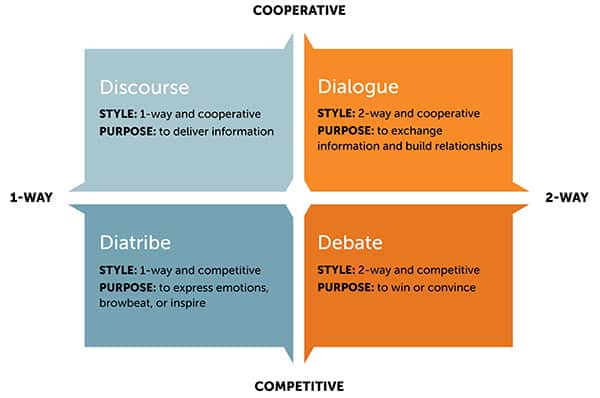Humanspeak series: Part 1 – Meaningful conversation

In this series, Humanspeak, we will provide insights into how to create more effective, compelling communications by humanizing the language of your brand.
This article was authored by our previous Executive Director of Verbal.
Part 1– From diatribe to dialogue: deeper human (and brand) connections start with meaningful conversation
Last week, under an outstretched oak tree on a sun-splashed New Jersey morning, I watched my son and his new classmates bunny hop from puddle of light to puddle of light. It was a joyful scene playing out in similar schoolyards from coast to coast. Un-masked students smiling and laughing. Un-Zoomed parents hugging and high fiving. Un-flappable teachers enthusiastically herding us into organized queues. The cacophony of real live people having real live conversations enveloped us all like an embrace from an old friend. It was a ritual so mundane, and yet so magical, especially coming out of Covid. Dropoff for the first day of school.
Feel good vibes all around. But this isn’t just a feel-good story about life getting back to normal (knock of wood) post pandemic. This is a story about reclaiming something we were losing, personally and professionally, even before the world shut down: meaningful conversation. The kind where we leave behind the shallows of small talk and dive deeper.
Learn more: Human Brand: Guiding Principles
Because as human beings, we crave connection. We are starving to be heard. To be understood. To be valued. To be loved. To belong.
Brands crave these same connections, too.
But how do we realize the connections that we crave? Walking across the field back to my car that morning, I asked myself that very question—both as a father and as a communications professional. How can I nurture the bond I share with my son? How can I make new friends in our new town? How can I strengthen the relationships I already have? And how can I help my clients do the same?
Through meaningful conversation. Whether it’s in-person or online, rekindling an old friendship or starting a new one, meaningful conversation cuts through the noise and straight to the heart of the connections we crave.
But what makes a conversation meaningful? To learn how, let’s go back to the schoolyard.
The four types of conversation
The word “conversational” belongs in the Hall of Fame inner circle of branding buzzwords. Forever we’ve been encouraging brands to sound more conversational. Speak naturally! Speak like you’re talking with a close friend! Favor personal pronouns and leave the jargon behind! All great advice, but standing there on the playground, enveloped by a prepubescent wall of squeal, I realized something foundational was missing from our advice. Strip away our typical communication’s bread and butter—tone of voice, messaging, segmentation, channel delivery, cadence, calls to action—and ask yourself this: exactly what kind of conversation do I want to have?
As the below chart demonstrates, there’s actually four types of conversation to consider, each with their own style and purpose. Two are competitive (1-way conversations) and two are cooperative (2-way conversations). All play a role, but ultimately only one shines above the others for cementing the connections we crave between one other and the brands we love.

Cover your ears, we’re about to experience each conversation type firsthand from one end of the schoolyard to the other—from least meaningful to most meaningful.
Conversation #1: Diatribe
My son, like all the other kindergarten boys, was wearing shiny new sneakers…and he had a lot to say about them. His were Pokémon. Other boys wore Spiderman, Iron Man, Hulk, Star Wars, Blippi, Sonic and Minions. After showing off how high they could jump, the kids gathered shoulder to shoulder in an impromptu circle, looking down. It was quiet for a second, until it was not. All at once each boy gave passionate sermons on why their sneakers were the best. It was like listening to 18 competing elevator pitches simultaneously.
“My shoes are yellow because yellow is the best color and the best Pokémon are all yellow.”
“Spiderman is awesome and so are my shoes and he catches bad guys with webs from his hands.”
“Minions are funny especially when they toot which I think is funny because cheese makes me toot and cheese is yellow like Minions.”
The boys had all the necessary ingredients you want in a communications strategy: distinct personality, nuanced understanding of subject matter, personal connection to the product. But the problem was they were all talking at the same time…and they were talking at each other! Zero breaths taken, zero ears open.
Brands can be guilty of the same approach—talking at their audiences, only talking about themselves. Fascinated by their version of shiny new shoes, but only adding to the noise not standing apart from it. I can teach my son how to out-shout the other kids. That may make him a more understandable communicator…but will it make him a compelling one?
How meaningful is a diatribe?
Brands, like humans, have a deep need for self-expression. We’re proud of who we are, excited about what makes us tick, and want to share those stories with the world. Used as an occasional seasoning, a good diatribe can help inspire people, sweeping them up with our expertise, confidence, and passion. But then we need to pivot and pivot fast from talking to listening…something kindergarten boys definitely struggle with. Because to make this type of conversation meaningful, they must communicate something deeper: WHY their sneakers matter to their audience, not just themselves. Beyond of course them being awesome and yellow and smelling like cheese.
Conversation #2: Debate
Beneath the first whisps of tween mustaches, in voices breaking from soprano to baritone and back again, the middle schoolers argue allegiances to local sports teams and video game consoles. Yankees vs. Mets (Yankees obviously). Jets. Vs. Giants. Xbox vs. PlayStation. Nintendo Switch vs. Oculus Quest. They’ve matured some since kindergarten, taking turns with their talking points. But not so much listening to each other as they are waiting for their chance to talk.
How meaningful is a debate?
Who doesn’t love a good debate? From dinner tables and bars to political pundits and policymakers, our society is built on them. Like diatribes though, debates are by nature competitive. Toxic debates can feel like all-out war, with only a zero-sum winner left standing. A healthy debate is both respectful and informed. People and/or brands have put some significant thought into the subject already and have come to the table backed with their research, knowledge, and experience to voice their input. It signals that you care enough about the subject to put some strong thinking into it and are committed to defending your stake in the ground.
But while debates can be a healthy conversation for problem-solving and alignment, their competitiveness make them a dicey choice. What if feelings get hurt? What if your opinions are not shared, no matter how well researched and strongly held? Especially in today’s hyper-charged world, debates can quickly escalate and alienate. Best to keep them within smaller circles while encouraging more open dialogue with broader audiences.
Learn more: 13 Ways for a company to create and cultivate a strong brand voice
Conversation #3: Discourse
The principal strolls to the center of the schoolyard, stands on a milk crate and raises a red folder above her head. Her confident demeanor commands attention. And even though she’s surrounded by hundreds of children, her voice carries clearly and calmly without a megaphone, welcoming us to the 2022 school year. She tells us to form six lines, one for each grade. Kindergarteners will enter the building first. Parents can pick their children up at 3 o’clock, and please do not park in the bus lanes marked by the yellow cones.
How meaningful is a discourse?
This conversation is all about information delivery. The reader/listener needs information—be it directions, instructions, guidance of some sort. The speaker/writer shares that information—clearly and concisely. Wrap it all up in a friendly, confident, experienced tone and both parties are happy. It was a pleasant transaction. It was a helpful transaction. And it was an entirely necessary transaction. But that’s all this type of conversation can ultimately be: a cooperative transaction.
Conversation #4: Dialogue
With our children safely inside the school, and this being a milestone day for us too, most of the parents linger under the grand oak tree. We weren’t ready to go home or back to work just yet. Collectively it felt like we were all yearning for something more.
There was small talk at first, there always is. Hi, my name is Pat, what’s your name? Yes, the kid with the Pokémon sneakers is my son. But then one of the parents started to cry. And then laugh. And then cry some more while laughing. Soon we were all doing the same as we took turns sharing our stories. We were survivors of the pandemic, sure—shielding our children from the horrors we witnessed and the anxieties we suppressed—to deliver them safely two years later, here, to this sunny schoolyard. Blink and they’ll be in college. Blink again and they’ll be calling you, excited and emotional, after dropping their own kids off for their first day of school.
How meaningful is a dialogue?
At first our conversation blended the other three types together: a bit of diatribe, a hint of debate, a dash of discourse. The details of each I forgot almost immediately. But what’s stuck with me, what made that moment memorable happened through dialogue.
How brand can use dialogue to create meaningful connections and lasting relationships
Effective dialogue is both a learned skill and an intuitive experience. Here’s how to make yours more meaningful:
Be present
You are 100% there, an active participant and focused listener in the moment with zero distractions.
Be inclusive
No one party dominates the conversation; everyone is actively involved, respected, and encouraged to participate.
Be emotional
Open up, be vulnerable, make it personal, make it count. Joy, anger, sadness or release, your emotions are the hook that pull people in.
Be profound
When a conversation allows you to better understand something important about yourself, the other person, or the world – then it really becomes meaningful.
Dialogue—the most powerful, and most human, communication tool we have. Without it, our lives would be mostly transactional. But with it, we have the potential to connect and the possibility to transform. The same holds true for brands.
Learn more about verbal identity and how it represents your brand by contacting us here.


